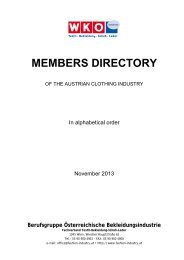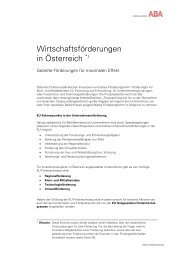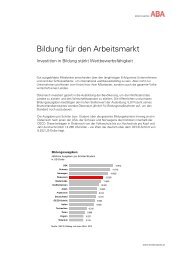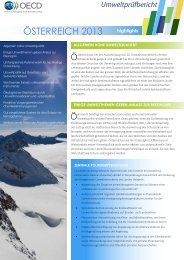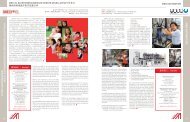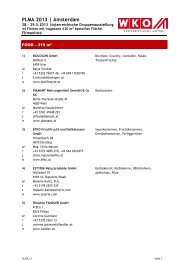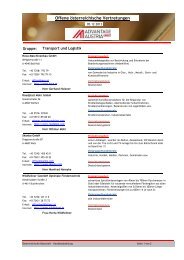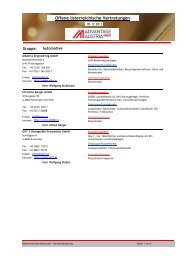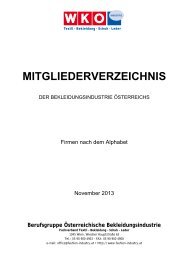AE Lebensmittel_ok.indd - Advantageaustria.org
AE Lebensmittel_ok.indd - Advantageaustria.org
AE Lebensmittel_ok.indd - Advantageaustria.org
Sie wollen auch ein ePaper? Erhöhen Sie die Reichweite Ihrer Titel.
YUMPU macht aus Druck-PDFs automatisch weboptimierte ePaper, die Google liebt.
AUSTRI<strong>AE</strong>XPORT<br />
No excessive use of the land: careful cultivation, use of<br />
natural fertilisers and proper crop rotation ensure the soil’s<br />
health and fertility.<br />
Animals are kept in a natural way: in <strong>org</strong>anic agriculture,<br />
domesticated animals live as naturally as possible.<br />
All feed must be <strong>org</strong>anic, and growth hormones, antibiotics<br />
and other kinds of performance enhancers are not<br />
permitted.<br />
Use of self-regulation mechanisms: in <strong>org</strong>anic agriculture,<br />
this means reliance on regulation mechanisms and<br />
self-healing processes in intact ecosystems.<br />
No genetic modifi cation: genetic technology of any<br />
kind is not used.<br />
According to Rudolf Vierbauch, head of Bio Austria,<br />
the availability of <strong>org</strong>anic pork, fruit and vegetable products<br />
is at present insuffi cient. In the Green Report of the<br />
Federal Ministry of Agriculture, Forestry, Environment<br />
and Water Management, the amount of domestic land<br />
being farmed <strong>org</strong>anically increased by 1,118 hectares, to<br />
approximately 361,487; in 2006, while at the same time<br />
the number of <strong>org</strong>anic farms dropped by 118. In the long<br />
term, Vierbauch claimed that approximately 10,000 new<br />
farms are necessary to guarantee the highest possible domestic<br />
supply and ensure reliability for the large distributors.<br />
In general, Austria is moving with the times, one example<br />
being that Anuga 2007 focused on “Wellfood”, defi ned<br />
as “fresh fruit and vegetables, wholemeal products, products<br />
with low or no fat and sugar, dietetic, probiotic and<br />
<strong>org</strong>anic foods”. This change has been taking place for some<br />
time now: foods should taste good and be satisfying, and at<br />
the same time be good for the eater’s health. Market research<br />
performed in Germany has confi rmed this fact: in<br />
the past fi ve years, the money spent by German households<br />
on Wellfood has increased by 25%, claimed a GfK study,<br />
while the market for food products overall grew by no more<br />
than fi ve percent during the same period. Moreover, the<br />
market for convenience foods enjoyed the highest growth<br />
rates of all sectors.<br />
The <strong>org</strong>anic trend continues<br />
At present, no less than 85% of all Austrians occasionally<br />
eat or drink <strong>org</strong>anic food products, nine percent buy <strong>org</strong>anic<br />
products (almost) exclusively. These fi gures are from a<br />
study performed by the ACNielsen marketing-research<br />
institute.<br />
In all, <strong>org</strong>anic products comprise nearly fi ve percent of<br />
total turnover in the food sector. Austrians choose <strong>org</strong>anic<br />
alternatives most often when buying baby food: 39% of<br />
turnover in this sector comes from <strong>org</strong>anic products.<br />
At more than 26%, the percentage of health foods such<br />
as breakfast cereal, muesli and oatmeal that are <strong>org</strong>anic is<br />
also extremely high. Of dairy products and other fresh<br />
produce (fruit, vegetables, bread, eggs, etc.), the share is<br />
considerably lower, 6.7%.This study also showed that individual<br />
consumers’ own health is the most important<br />
sales argument. In addition, Austrians, contrary to the<br />
worldwide average, are also interested in the conditions<br />
Schonende Bodennutzung: Durch schonende Bearbeitung,<br />
Ausbringung natürlicher Dünger und ausgewogene<br />
Fruchtfolgen werden die Bodengesundheit und -fruchtbarkeit<br />
gefördert.<br />
Artgerechte Tierhaltung: In der Biolandwirtschaft werden<br />
die Nutztiere besonders tierfreundlich gehalten. Futtermittel<br />
müssen ebenfalls biologischer Herkunft sein, Leistungsförderer<br />
oder Antibiotika sind verboten.<br />
Nützen natürlicher Selbstregulierungsmechanismen:<br />
Bei der biologischen Landwirtschaft wird auf natürliche<br />
Regulationsmechanismen und Selbstheilungsprozesse in<br />
intakten Ökosystemen gesetzt.<br />
Keine Gentechnik: BiobäuerInnen verzichten ausnahmslos<br />
auf den Einsatz von Gentechnik.<br />
Laut Rudolf Vierbauch, Obmann von Bio Austria, sollte<br />
insbesondere bei Schweinefl eisch, Obst und Gemüse das<br />
Angebot ausgebaut werden. Laut Grünem Bericht ist 2006<br />
die heimische Bioanbaufl äche zwar um 1.118 ha auf rund<br />
361.487 ha gestiegen, gleichzeitig sank aber die Zahl der<br />
Biobetriebe um 118. Langfristig seien aus seiner Sicht etwa<br />
10.000 zusätzliche Betriebe notwendig, um vor allem den<br />
großen Vermarktern Liefersicherheit und insgesamt eine<br />
möglichst hohe Inlandsvers<strong>org</strong>ung garantieren zu können,<br />
sagt Vierbauch.<br />
Generell liegt Österreich voll im Trend, setzte doch auch<br />
die ANUGA 2007 voll auf „Wellfood“ (laut Defi nition<br />
„frisches Obst und Gemüse, Vollkornprodukte, fett- und<br />
zuckerreduzierte/-freie Produkte, diätetische, probiotische<br />
und biologisch erzeugte <strong>Lebensmittel</strong>“). Diese Entwicklung<br />
zeichnet sich schon seit einiger Zeit ab: <strong>Lebensmittel</strong> sollen<br />
gut schmecken und satt machen, aber auch der Gesundheit<br />
zugute kommen. Auch die deutsche Marktforschung bestätigt<br />
das: In den vergangenen fünf Jahren sind einer GfK-<br />
Studie zufolge die Ausgaben der deutschen Haushalte für<br />
Wellfood um 25 Prozent gestiegen, während der Markt für<br />
Ernährung insgesamt nur um fünf Prozent wuchs. Zudem<br />
verzeichnet der sogenannte Convenience-Markt schon seit<br />
Jahren die höchsten Zuwachsraten aller Sparten.<br />
Der Biotrend hält an<br />
Schon 85 Prozent der ÖsterreicherInnen greifen gelegentlich<br />
zu Biolebensmitteln, neun Prozent kaufen (fast) ausschließlich<br />
Bioprodukte: Zu diesem Ergebnis kommt eine aktuelle<br />
Studie des Marktforschungsinstituts ACNielsen.<br />
Insgesamt machen Bioprodukte bereits fast fünf Prozent<br />
des gesamten Umsatzes im <strong>Lebensmittel</strong>bereich aus. Am<br />
stärksten greifen die ÖsterreicherInnen bei Babynahrung<br />
zur biologischen Alternative: 39 Prozent des Umsatzes entfallen<br />
in diesem Bereich bereits auf Bio.<br />
Mit mehr als 26 Prozent ist der Bioanteil auch bei Reformwaren<br />
wie Müsli und Haferfl ocken sehr hoch. Bei Molkereierzeugnissen<br />
und den übrigen Frischwaren (Obst, Gemüse,<br />
Fleisch, Brot, Eier etc.) ist der Anteil mit 6,7 Prozent deutlich<br />
niedriger. In der Studie wurde auch festgestellt, dass die<br />
eigene Gesundheit das wichtigste Argument für den Kauf<br />
ist. Den ÖsterreicherInnen ist außerdem – anders als im<br />
weltweiten Schnitt – auch der Aspekt der tierfreundlichen<br />
Haltung beim Kauf von Bioprodukten wichtig. 28 Prozent<br />
12 www.advantageaustria.<strong>org</strong><br />
127/2008



